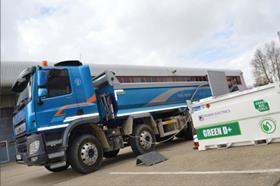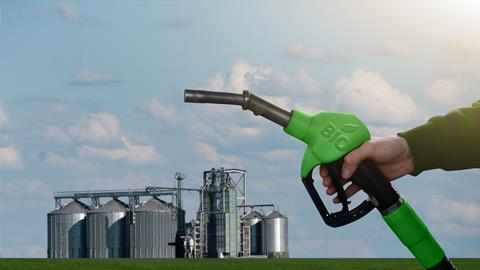While the debate over whether zero emission HGVs will be powered by batteries or hydrogen or both, Green Biofuels is quietly getting on with helping operators including Hovis, Travis Perkins and CEVA Logistics cut their CO2 emissions by up to 90% and NOx emissions by 30% now by replacing standard diesel with its Green D+ bioliquid fuel.
There are rumours in the market however that some unscrupulous suppliers are jumping on the biofuels bandwagon and selling product that is far from clean or renewable.

“It’s a very high value product and everyone wants to ride on the back of it,” says William Tebbit, CEO of Green Biofuels. “We have put in a lot of effort to get to the position we are in.
“In a way we want people to break the law every now and again because we want them to be caught and punished. It has happened several times and that shows the system is working.”
BP took a 30% stake in Green Biofuels last year after five “challenging” years of Tebbit and co-owner Magnus Hammick building the business from almost nothing to a forecast £300m turnover in the current year.
“There were a number of reasons for doing that,” says Tebbit. “Strategically they are one of the biggest traders of biofuels in the world and they have a slightly bigger balance sheet than us! That makes them a good partner as we can source product from anywhere in the world helping to satisfy our clients demands.”
Renewable sources
To date Green Biofuels has bought hydrogenated vegetable oil (HVO) base product mainly from Finnish renewable fuels giant Neste, importing it in bulk to its two main storage facilities on the Thames and in Liverpool.
The fuel is then dosed with a special additive package the company has developed to improve the performance of standard HVO. It calls this product Green D+, which it markets as a 100% renewable low emissions “bioliquid” fuel rather than biodiesel which, although sharing common feedstocks, results in a fatty acid methyl ester (FAME) that is regarded as a lower quality product than more advanced fuels like HVO.

Tebbit, pictured, says that not all biodiesels are the same and some high blend biodiesel/EN590 blends produce worse emissions than standard EN590 diesel. “Because there are problems with the way some of these fuels are made and blended, you are not going to get the quality of fuel that you get with a hydrogenation process,” he argues. “The market and regulators will determine that some biodiesels will not be able to meet the standards of these advanced fuels.
“That will take away the feedstocks from the biodiesel industry and free them to come into advanced fuels such as HVO. That will mean more investment in refineries and we will be able to very significantly increase the amount of HVO made.”
Obsession with feedstocks
He says the market has an “obsession” with feedstocks which can be both healthy and unhealthy.
“We only source product that is waste-derived and gives the highest greenhouse gas saving,” Tebbit says. “That is certified by the proof of sustainability [POS] we get from the manufacturer. There are more and more people starting to produce HVO and because the Neste product is the most expensive, where there is that differential on pricing some people will go for the cheaper product with less sustainability documentation. We are registered with the ISCCC, a globally recognised organisation that verifies a supply chain’s sustainability.”
One way operators can confidently certify the sustainability of renewable fuels is through the Renewable Fuels Assurance Scheme (RFAS) launched last by the Zemo Partnership to provide a mechanism for guaranteeing that fleet operators are purchasing bulk supplies of sustainable low carbon fuels. It now has 14 suppliers including Green Biofuels signed up.
“It was an obvious missing link,” says Tebbit. “You could buy a cargo [of HVO] with a POS and bring into the UK but there was no check from there onwards to the end customer. It contains the same information you would expect in a POS but it is broken down to the volume of product that is supplied to that particular customer and provides the customer with an assurance around sustainability.
“That scheme is a year old and it is doing well. If you want to make sure you get sustainable product you can do so.
“It is a cheap shot to say ‘all this stuff isn’t really used cooking oil’. We had a cargo in the other day and the feedstock was all UK-derived food waste so the feedstocks are broadening. As the price of the product goes up that opens things up and there are enough waste products globally available to produce a huge amount of HVO and other advanced fuels.
“People want to source different feedstocks and the cellulosic and wood waste from forestry are starting to be looked at much more. There are established procedures for how you measure and record sustainability.”
Prices rising
The price of HVO is linked to diesel and that, along with rising demand as more operators switch to renewable fuels, has driven prices higher.
“HVO products are priced at a premium over gas oil so they are linked,” says Tebbit. “Demand has also increased very significantly. Last year we did about 50m litres and this year we will probably do 300m or 400m litres. It is still relatively small in the overall scheme of diesel consumption, but it is having a massive effect.”
The UK diesel market is around 34bn litres a year, 26% or 9bn litres of which goes into transport, and Green Biofuels could supply up to 1bn of that – what Tebbit calls “a big niche in a massive market”.
“For operators of HGVs there really isn’t a viable low carbon solution that you can roll out today,” he says. “As a transition technology it is fantastic. Not only does it reduce carbon emissions it also improves air quality.”
If every operator wanted to switch to GD+ tomorrow, is there enough to go around - assuming the price was right?
“No there isn’t, and that isn’t the feedstock, it is the refining capacity,” admits Tebbit. “There are refineries being commissioned or upgraded, and a number of refineries around the world have been taken out of fossil fuel production and put into renewables. It will take time for refining capacity to catch up with the feedstocks.”
It is even possible that renewable fuels will be made in the UK.
“Esso at Stanlow has started looking at renewable hydrogen, the Chinese are looking at if they can sell out of Petro Ineos at Grangemouth and if they do I suspect someone may come in and do something there, and Esso at Fawley I know is also interested in it,” says Tebbit. “It will probably start with a retrofit of an existing facility. That would be brilliant and we would fully support it.”
Another big question is how long a future do biofuels have in the UK. The government remains committed to ending sales of non-zero tailpipe emissions trucks under 26 tonnes by 2035 and of heavier trucks by 2040.
Long future
But the Office for Zero Emission Vehicles (OZEV) believes that low carbon fuels (LCFs) as it calls them can contribute a significant proportion of the emissions savings in the transport sector and play an important role in reducing emissions from HGVs by displacing fossil fuels. It expects long-haul HGVs to remain a “significant user” of LCFs for “decades to come”, implying a date long after 2035 when there will still be many thousands of diesel-powered trucks on UK roads.
“I am pleased that they are being realistic for a change,” says Tebbit. “When the ban on new diesel vehicles comes in there is going to be a massive rush to buy as many diesel vehicles as possible. There are 480,000 HGVs on the roads with an average life of eight to 10 years, so they are going to be there for 10 years at least after that point.
“There is nothing wrong with a diesel engine – it is what you put in it that is the problem. Why would you throw away something like an HGV with a 10 year life span if you can put something clean in it?

“Liquid low carbon fuels have traditionally been incredibly efficient means of transporting energy until you need it. When you look at some of the solutions that are being discussed they are a lot less efficient. We need to accept the fact that technology will advance but it isn’t here yet. And it isn’t just about the technology – is the infrastructure to support it viable and at scale?
“There is no single solution. Low carbon fuels should be used where they have most effect. Light vehicles should go electric because that technology is pretty usable but the bigger the diesel engine and the longer the life, then that should be using low carbon fuels.”
At present operators must have their own on-site bunker to use GD+ as unlike the electricity and gas grids it is not possible to ‘inject’ renewable fuel into a diesel network and draw off the equivalent amount elsewhere.
“The National Grid is the biggest mass balance network and I love it when people tell me they are buying green electricity,” says Tebbit. “I tell them ‘no you’re not, you are buying a mass balance grid’. Today on the National Grid electricity has probably about 250g of CO2 equivalent per kWh – we are 34g whether or not it is sunny or windy.
“If you’re a haulier with your own tanks we will deliver to you. If you don’t have tanks we will provide them. Travis Perkins for example has 400 or 500 sites where we are putting tanks in. When you have a clean fuel you have to build your own network which is what we are doing now.”
What’s in a name?
As the demand and price of HVO rises, more renewable feedstocks other than used cooking oil will become economically viable to produce road fuel. So will HVO still be an accurate description of GD+?
“We tend to classify it to the EN15940 standard which also includes GTL [gas to liquid] and both renewable and non-renewable fuel,” explains Tebbit. “Because our Green D+ brand has started to get some awareness in the market we just refer to it as GD+.
“We have also launched a co-branded product with Shell called ‘GD45 powered by Shell GTL’ which is designed for trains.”
The link with Shell came about before BP became a shareholder in Green Biofuels – and it produces GTL from natural gas. While this is not a renewable fuel it burns cleaner than diesel and produces less carbon and fewer local pollutants.
“Because GTL is less expensive than HVO, GD45 powered by Shell GTL allows operators to graduate their transition,” says Tebbit. “It gives a 45% to 55% carbon saving.”
There is also some confusion about what is a waste product that can be used to make a renewable biofuel, which is not surprising as the regulations within the second version of the Renewable Energy Directive (RED II) are complex.

Annex IX of RED lists two highly sustainable feedstocks that the European Commission has decided are worthy of a stimulus to make them more attractive than fuel derived from agricultural and energy crops.
These are used cooking oil and animal fats, and they are promoted by making them eligible for ‘double counting’ when it comes to assessing the EU’s progress towards carbon reduction targets. Some dismiss this however an “accounting trick” that creates the “illusion” that the EU is moving towards fulfilling its commitments to carbon reduction in transport.
“The waste-derived products that qualify for double counting are listed in RED II,” says Tebbit. “That sets out what are good wastes and what qualifies as ‘waste derived’. So there are virgin oils - such as rape seed but probably not palm oil because that is bloody expensive - that can be used in a low carbon fuel.
“But they are not double-counting products so we would not buy those. Everything we sell is waste-derived. People go on about palm oil and I say to them ‘stop eating chocolate and stop using soap’. Look at all the products on the shelves that contain virgin palm oil.
“It does not make economic sense to put virgin palm oil into fuel. There are far higher margins in those other products. But because some palm oil is produced from sustainable plantations, those plantations produce waste and that waste is described as POME [palm oil mill effluent] which is a by-product of palm oil production. That is a good waste and can go into HVO.
“There is also spent bleach and that can be used. It has to be a waste from any process. Neste does use POME but only from plantations established before 2007 which do not cause deforestation.”











